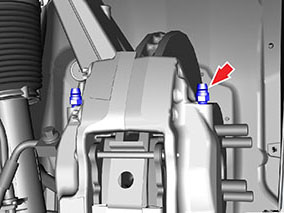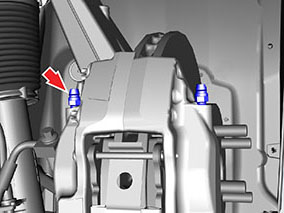Tesla Model X: Bleed Procedure - One Caliper (Remove and Replace)
Bleed
Note: The bleed procedure requires bleeding through the outboard bleed nipple of each caliper, bleeding through the inboard bleed nipple, then bleeding through the outboard bleed nipple again.
Note: A pressure bleeder is required to properly bleed the brake system. Do not use a vacuum bleeder.
- Remove the rear underhood apron (refer to procedure).
- Disconnect 12V power (refer to procedure).
- Remove the road wheel (refer to procedure).
- Clean the area surrounding the brake fluid reservoir cap, then remove the cap. Note: Place suitable absorbent material around the affected area to absorb any possible fluid spillage. Caution: If brake fluid is spilled on a painted surface, wash off immediately with clean water.
- If the brake fluid is excessively dirty, use a syringe to remove the brake fluid from the reservoir.
- Top off the brake fluid reservoir. Warning: Use the brake fluid specified in this manual only (General Information > Fluids and Capacities > Fluids). Warning: Use only new brake fluid from a sealed container. Do not reuse brake fluid.
- Install the pressure bleeder on the reservoir. Fill the pressure bleeder with sufficient brake fluid to replace all fluid used during the bleed procedure. Warning: Use the brake fluid specified in this manual only (General Information > Fluids and Capacities > Fluids). Warning: Use only new brake fluid from a sealed container. Do not reuse brake fluid. Note: This procedure requires a significant amount of fluid. Make sure that the pressure bleeder reservoir is adequately filled before continuing.
- Set the pressure bleeder to 30 PSI (2.07 bar).
- Pressure bleed the affected caliper.
- Attach a brake bleed container to the outboard bleed nipple
on the caliper.
Note: Place suitable absorbent material around the affected area to absorb any possible fluid spillage.

- Loosen the bleed nipple one quarter turn counterclockwise.
- Tighten the bleed nipple once a flow of clean, air-free fluid is purged into the container (torque 17-20 Nm)
- Disconnect the bleed container and clean any brake fluid from the caliper.
Caution: If brake fluid is spilled on a painted surface, wash off immediately with clean water.
- Attach a brake bleed container to the outboard bleed nipple
on the caliper.
- Repeat step 9, using the inboard bleed nipple.

- Repeat step 9, using the outboard bleed nipple a second time.

- Leave the pressure bleeder attached to the reservoir.
- Manually bleed the affected caliper.
- Attach a brake bleed container to the outboard bleed nipple
on the caliper.
Note: Place suitable absorbent material around the affected area to absorb any possible fluid spillage.

- Have an assistant press and hold the brake pedal. Note: Do not release the pedal until the bleed nipple is closed again.
- Loosen the bleed nipple one quarter turn counterclockwise.
- Tighten the bleed nipple (torque 17-20 Nm).
- Have the assistant release the pedal.
- Repeat steps 13b-13e 4 times.
- Disconnect the bleed container and clean any brake fluid from the caliper.
Caution: If brake fluid is spilled on a painted surface, wash off immediately with clean water.
- Attach a brake bleed container to the outboard bleed nipple
on the caliper.
- Repeat step 13, using the inboard bleed nipple.

- Repeat step 13, using the outboard bleed nipple a second time.

- Remove the pressure bleeder in accordance with the manufacturer's instructions. Caution: If brake fluid is spilled on a painted surface, wash off immediately with clean water.
- Check the brake fluid level, and top off the fluid if required.
- Install the brake fluid reservoir cap.
- Reconnect 12V power.
- Reinstall the road wheel.
- Sit in the driver's seat and pump the brake pedal several times. Check for a short, firm travel when the brakes are applied. Note: If the brake pedal is soft, bleed the complete system (refer to procedure).
- Perform a road test using a series of ABS-active stops and ensure proper brake pedal feel and performance.
Note: If the brake pedal is soft, bleed the complete system (refer to procedure).
